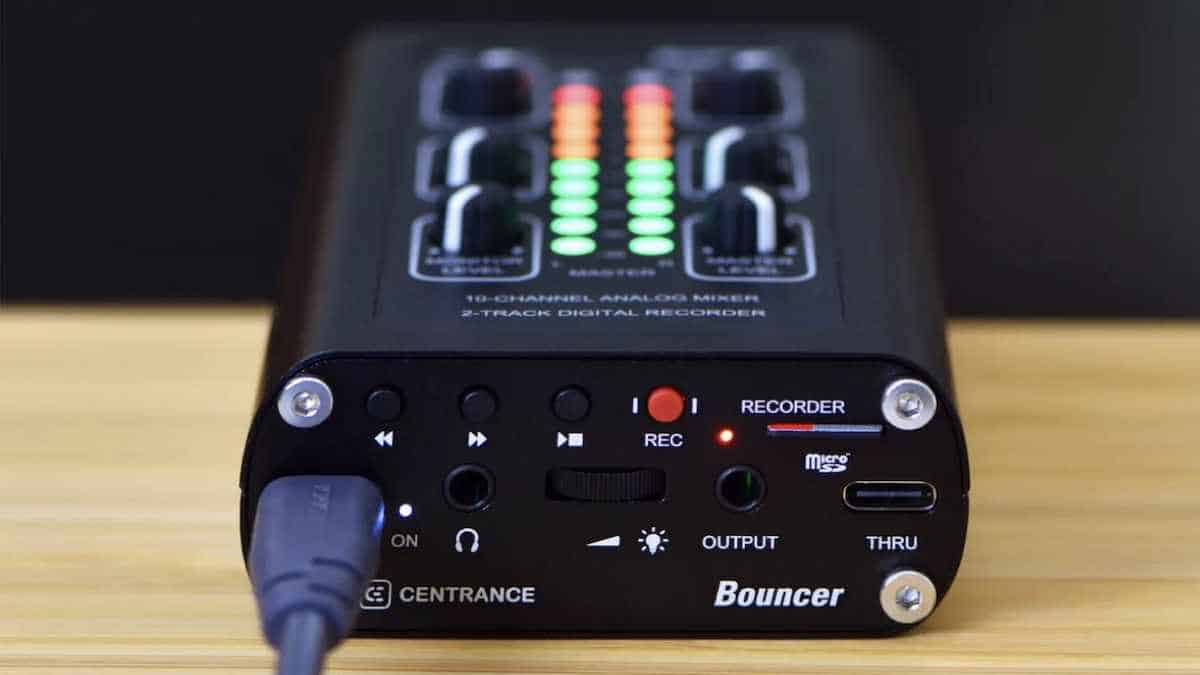In This Issue
CEntrance Bouncer Mixer/Recorder – the Synth and Software Review

It’s tiny, it’s all analog (except the 2-track microSD recorder), and it’s a 10×2 line mixer with a headphone amp
Is a 10×2 analog line mixer with a built-in stereo recorder and headphone amp bigger or smaller than a piece of string?
Smaller, of course. Here’s a picture of CEntrance’s Bouncer inside the outline of a big iPhone (12 Pro Max, but there are lots of models this size) – the same size as their DACport Pro (click on that to see my review) and several other of their high-quality “problem-solvers.”
This little USB-powered mixer incorporates five stereo inputs, stereo out, a very nice headphone amp, and a built-in stereo microSD card recorder. And it sounds clean.
Overview. While the Bouncer has any number of applications, the one CEntrance puts at the top of its list is recording – bouncing – live jam sessions, including synth jams.
Presumably because of that (and the unit’s size) the five stereo inputs, stereo outs, and headphone jack are all on 3.5mm (1/8″) TRS jacks. That’s the right size for little synths, Eurorack patch cables, iPad and similar outputs, and, um, adapters from 1/4″ connectors. You’ll read the riveting Tale of the Absent-minded Reviewer Who Ordered the Wrong Cables later.
Calm down, please.
The first four input pairs have level controls, signal present (-30dB), and peak (-6dB) lights on the top panel; the fifth stereo input is just at unity gain – meaning you adjust its level at the source. It seems to be intended for daisychaining multiple Bouncers for more inputs, but of course you can use it for any line-level source.
While this is a diminutive piece of equipment, the Bouncer’s LED meters are a healthy size for viewing from a distance. They have ten segments and display both PPM (peaks) and VU (average signal), and there’s a brightness control on the front.
The Bouncer has a mic stand mounting hole, or you can put it on your desktop. You’ll need it somewhere within reach to adjust input levels and operate the recorder controls, but it’s more of a set-and-forget mixer than one you’re likely to use for dynamic level adjustments.
Having said that, the little level controls have a smooth, precise feel without any play. Unlike cheap pots, they don’t produce weird level jumps near the bottoms of their ranges.
That saga. As with all desktop equipment, you’re going to have cables all over the shot. It’s unavoidable. The Bouncer has its inputs on the rear, headphone and line outs on the front, you’ll need USB for power, there’s a USB thru connector to power another Bouncer (or other device)… and you might need adapters.
About those 3.5mm connectors. You probably don’t want to brag about them at a cocktail party full of mastering engineers, because they’ll say you need larger connectors for optimum audiophilia. No one else cares – they work just as well as 1/4″ or XLR connectors for all normal purposes, and the proof is the way the Bouncer sounds.
As to that riveting tale advertised above: without thinking I ordered some regular stereo 1/4″ TRS to 3.5mm TRS cables to interface the Bouncer to my studio for this review.
Nope. What you need is dual 1/4″ mono to 3.5mm “splitter” aka “breakout” cables. They’re often sold for connecting an iPad or Android phone to a regular stereo receiver – and in fact they work for that too. Those of us with project studios also know this wiring scheme as a send/return cable, only these have a 3.5mm stereo connector on the main business end.
Oops.
Recording. Not a lot to report here, because the Bouncer’s recording feature works as expected: you hit Record to record, hit Stop/Play to toggle between playing and stopping, and Previous/Next do what you’d expect. What you hear going in is what you hear playing back.
CEntrance has long since fixed an issue on early units with the recording levels being higher than expected.
Another heads-up if you’re choosing a microSD card for the Bouncer. You can transfer its recording to a computer with a standard card reader. I selected a microSDXC UHS-1 card (the very latest protocol is UHS-II), but of note it came with an adapter to the larger standard SDs.
That allowed it to be read by the SDXC port on a Mac Studio. Oh, and you have to format cards larger than 32GB on the Bouncer. It’s simple.
Boing boing. One Bouncer application that CEntrance suggests is to impart “analog goodness,” using it as a summing mixer. There are audio companies that hang their hats on analog summing boxes, the idea being that, and we quote from CEntrance’s website: “analog mixing offers tighter bass, wider stereo field, and a more forgiving sound with high headroom.”
You can certainly hear what it does: round out the sound. It’s on the subtle side, but it’s an effect I’d certainly make use of.
Sold? Yes. This is a very straightforward line mixer/recorder that sounds good and has a lot of uses. The entire instruction manual fits on two sides of a little card, and that tells you all you need to know.

















